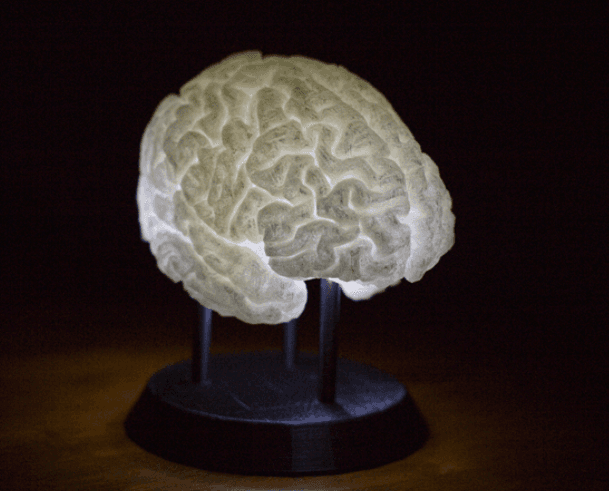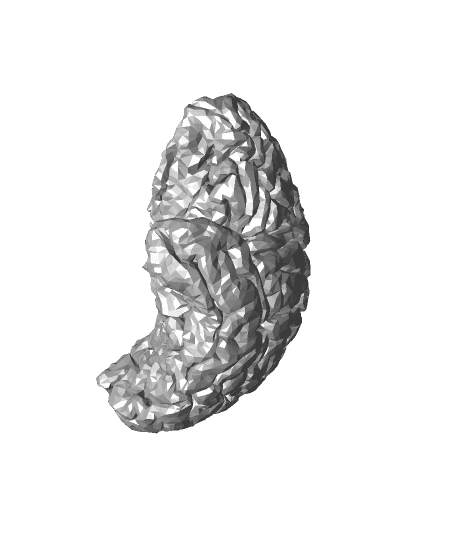Brain with ALS
A full-scale replica of a human brain. It was modeled from an patient with ALS via MRI scan. Also included is printable stand, & three supports.
Brain: Print using standard settings, with supports and a raft, using natural (clear) filament. Position each hemisphere of the brain with the flat side downward, parallel to the print surface. We printed the brain hemispheres approximately 5mm above the print surface, to make the supports easier to remove.
Amyotrophic lateral sclerosis (ALS) is a progressive neurodegenerative disease that causes muscle weakness and death from respiratory failure within 3–5 years after diagnosis. The cause of ALS remains unknown, but researchers believe that genetic mutations play a role.
ALS affects approximately 35,000 Americans each year. There is no cure or effective treatment for ALS at present.
There are several types of ALS, and they differ in their symptoms, progression rate, and age of onset. The two main types are sporadic and familial. Sporadic ALS occurs randomly throughout life without family history. Familial ALS has a strong genetic component, meaning that some families carry a mutation that increases risk of developing the disease.
About 90% of people with ALS have a form known as “limb-onset” ALS. This type of ALS begins with weakness in one arm or leg and then spreads to other limbs over time. About 10% of people with ALS develop “bulbar-onset” disease, which starts in the muscles around the lungs and throat. Bulbar-onset ALS can lead to breathing problems and swallowing difficulties. In about 1% of cases, ALS develops into what is called “cortical” or “brain-stem” ALS. Cortical ALS usually strikes people between 40 and 60 years old and may be fatal within 2–3 years. Brain-stem ALS typically appears earlier than cortical ALS; however, it also tends to progress more quickly.
The average survival time following diagnosis is three to five years.
Symptoms can include:
- Muscle twitching/spasms
- Loss of coordination
- Slurred speech
- Difficulty speaking
- Failed eye movements
- Decreased movement of arms and legs
- Trouble swallowing
- Weakness of hands and feet
- Fatigue
- Inability to move
- Progressive paralysis
- Death
What is the difference between ALS and Motor Neuron Disease?
Motor neuron diseases are caused by damage to motor neurons, which are located in the central nervous system. These neurons send signals to the rest of the body via nerves. They are important because they allow us to move our bodies.
Motor neuron diseases are not the same thing as amyotrophic lateral sclerosis (also called ALS). Motor neuron diseases affect the function of the motor neurons. Amyotrophic lateral sclerosis affects the functioning of the nerve cells that control voluntary muscle movement.
How does ALS spread?
ALS is a disorder of the nervous system. It is characterized by degeneration of both upper and lower motor neurons. Upper motor neurons connect the brain to the spinal cord where lower motor neurons reside. Lower motor neurons transmit information from the brain to skeletal muscles. When these neurons die, communication between the brain and muscles is lost. As a result, the patient loses the ability to voluntarily activate muscles.
Lower motor neurons are destroyed first. Once this happens, the upper motor neurons cannot take over and help the lower ones. Therefore, the patient becomes progressively weaker.
Why do patients lose strength?
When the lower motor neurons die, the muscles begin to atrophy. Atrophy means shrinkage. The lower motor neurons are responsible for sending messages to the muscles telling them when to contract and relax. Without these messages, the muscles become weak. Eventually, the muscles will waste away and eventually stop working altogether.
Lower motor neurons are destroyed first because they are closer to the site of injury. For example, if you injure your hand, the message goes directly to the hand before going to the rest of your body. If you injure your foot, the message travels through the spine and down to the toes.
ALS, is more commonly known as Lou Gehrig's Disease is a progressive nervous system condition that affects the brain and spinal cord. This degenerative illness leads to progressive loss of muscle control and eventually death.
Lou Gehrig's Disease, or Amyotrophic Lateral Sclerosis (ALS) is a progressive neurological disease that can affect nerve cells in the brain and spinal cord. It causes loss of muscle control, and eventually leads to paralysis.
There are two types of ALS: sporadic and familial. Sporadic ALS accounts for 90 percent of all cases of the disease, while familial ALS accounts for 10 percent. Sporadic ALS follows no particular pattern or inheritance pattern, while familial ALS is passed down through generations in families with certain genetic mutations.
ALS is a rare disorder that can affect anyone at any age. There is no cure for this disease but there are treatments to help ease symptoms like pain management and respiratory care to prolong life expectancy.
Introduction to Amyotrophic Lateral Sclerosis: What is ALS?
Amyotrophic lateral sclerosis (ALS) can be a rapidly progressive neurodegenerative disease that destroys nerve cells in both the brain and spinal cord. Motor neurons reach from the brain to the spinal cord and from the spinal cord to the muscles throughout the body. The progressive degeneration of these motor neurons leads to their death. When the motor neurons die, the ability of the brain to initiate and control muscle movement is lost.
The disorder eventually leads to total paralysis of all voluntary muscles, including those used for breathing. The cause of most cases of ALS is unknown, but genetics plays a role in some people with familial ALS.
ALS (Amyotrophic lateral sclerosis) affects about 2 people out of every 10,000 people worldwide each year. It is twice as common in men as women and typically starts between the ages of 40 and 70.
What are the Symptoms of ALS Disease?
The symptoms of ALS disease may vary from person to person. However, the most common symptoms include:
-Muscular atrophy and weakness in certain parts of the body. The muscles that are usually affected are those in the hands, arms, legs, and feet.
-Difficulty in speaking or swallowing food. This is because ALS affects the nerves that control vocal cords and muscles in the throat.
-Frequent drooling due to difficulty swallowing food or saliva
-Difficulty breathing because ALS affects respiratory muscles
keywords: amyotrophic lateral sclerosis symptoms, lou gehrig's disease symptoms
What are the Causes and Treatment Options for ALS?
ALS is a progressive neurodegenerative disease that affects nerve cells in the brain and the spinal cord. The progressive degeneration of these cells leads to muscle weakness, paralysis, and atrophy.
There are two main types of ALS: Lou Gehrig's Disease (also known as Amyotrophic Lateral Sclerosis) and Primary Lateral Sclerosis. There are three main causes of ALS: genetic mutations, environmental toxins, and head trauma. There are a variety of treatment options available for ALS patients including medication, physical therapy, surgery, stem cell transplants and more.
ALS, or amyotrophic lateral sclerosis, is a progressive neurodegenerative disease that affects nerve cells in the brain and the spinal cord. The progressive degeneration of these cells leads to muscle weakness, paralysis and atrophy.
Why is Stem Cell Research Important for ALS?
Stem cell research is important for the management of ALS because it helps in the development of new treatments to combat this disease. Stem cells are capable of transforming into any other cell type in the body and therefore can be used to replace diseased cells.
The use of stem cells in ALS research is a novel approach that has been shown to be promising. The use of stem cells in ALS research has been successful as they have been able to transform into neurons, which are lost during the progression of this disease.
The Future of ALS Research in 2022 & Beyond
ALS is a progressive and fatal disease that affects the nerve cells in the brain and spinal cord. It is also known as Lou Gehrig’s disease.
The future of ALS research in 2022 & beyond looks promising. Scientists have already made significant progress in their understanding of the disease and have identified potential treatments.
Learn More From Local Support Groups in your Area or the Following: https://www.als.org/research https://hsci.harvard.edu/related-news-topic/als https://als.ca/research/ https://stemcellthailand.org/therapies/als-amyotrophic-lateral-sclerosis/ https://www.mndaustralia.org.au/research

